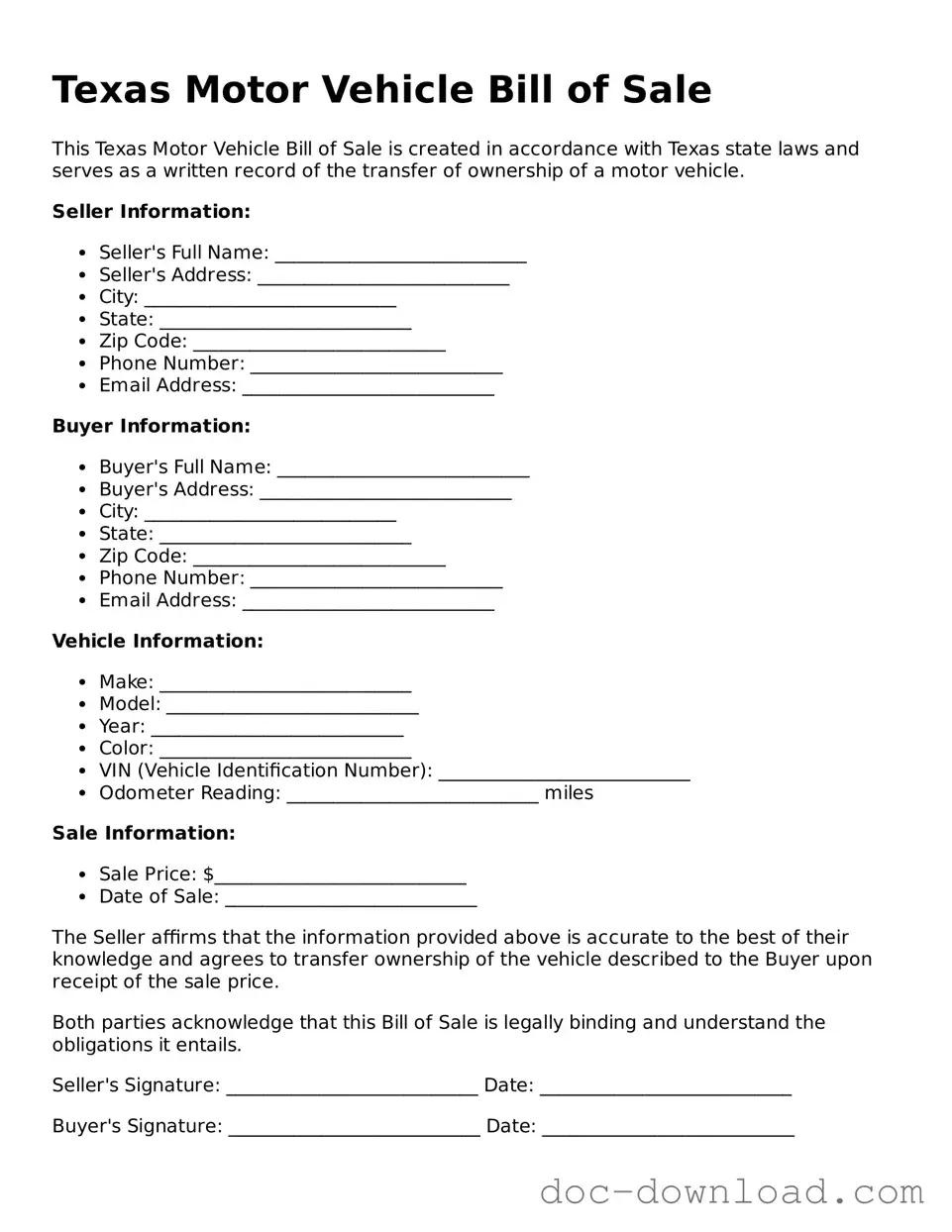The Texas Motor Vehicle Bill of Sale form shares similarities with the general Bill of Sale, a document used across various states to transfer ownership of personal property. This document typically includes details about the buyer and seller, a description of the item being sold, and the sale price. Just like the Texas form, a general Bill of Sale serves as a receipt for the transaction and can be used as proof of ownership. It is essential for both parties to retain a copy for their records, ensuring clarity in the ownership transfer process.
The Employment Verification form is crucial for validating an individual's work history and employment details. This document is widely used in situations such as securing loans or renting property. For a comprehensive understanding of this document, refer to the guide on how to handle Employment Verification requests.
Another document akin to the Texas Motor Vehicle Bill of Sale is the Vehicle Title Transfer form. This form is crucial when ownership of a vehicle changes hands, as it officially updates the vehicle's title to reflect the new owner. While the Bill of Sale provides a record of the transaction, the Vehicle Title Transfer is often required by the state to register the vehicle under the new owner’s name. Both documents work in tandem to facilitate a smooth transfer of ownership and ensure compliance with state regulations.
The Odometer Disclosure Statement is another important document that aligns with the Texas Motor Vehicle Bill of Sale. This statement is required during the sale of a vehicle to disclose the current mileage, preventing fraud related to odometer tampering. Similar to the Bill of Sale, it includes details about the buyer and seller, as well as the vehicle's identification. Ensuring accuracy in this disclosure protects the interests of both parties and maintains the integrity of the vehicle's history.
The Vehicle Registration Application is also similar in purpose and function. When a vehicle is sold, the new owner must register the vehicle with the state, which requires submitting this application along with the Bill of Sale and other pertinent documents. The application collects information about the vehicle and its new owner, ensuring that the state has accurate records. This process is crucial for establishing legal ownership and ensuring that the vehicle is properly registered for use on public roads.
The Affidavit of Heirship can also be compared to the Texas Motor Vehicle Bill of Sale, particularly in situations where a vehicle is passed down through inheritance. This document serves to establish the rightful ownership of a vehicle when the original owner has passed away. Similar to a Bill of Sale, it provides a legal basis for the new owner to claim the vehicle, especially when there is no formal title transfer. It helps clarify ownership and can be essential for heirs in managing inherited assets.
The Power of Attorney form can be seen as a related document, especially when a seller is unable to be present for the sale of their vehicle. This legal document allows one person to act on behalf of another in the transaction. When combined with the Bill of Sale, it ensures that the sale can proceed smoothly, even if the seller cannot be physically present. This arrangement protects the interests of both parties by providing a clear authority for the transaction.
The Sales Agreement is another document that bears resemblance to the Texas Motor Vehicle Bill of Sale. This agreement outlines the terms and conditions of the sale, including payment details, warranties, and any contingencies. While the Bill of Sale serves as a receipt, the Sales Agreement provides a more comprehensive overview of the transaction, ensuring that both parties are aware of their rights and obligations. It can be particularly useful in more complex sales where additional terms need to be documented.
Finally, the Release of Liability form is similar in that it protects the seller from future claims related to the vehicle after the sale. Once the vehicle is sold, the seller can use this form to formally notify the state and any relevant parties that they are no longer responsible for the vehicle. This document complements the Bill of Sale by providing an additional layer of security for the seller, ensuring that they are not held liable for any incidents involving the vehicle after the transfer of ownership.
